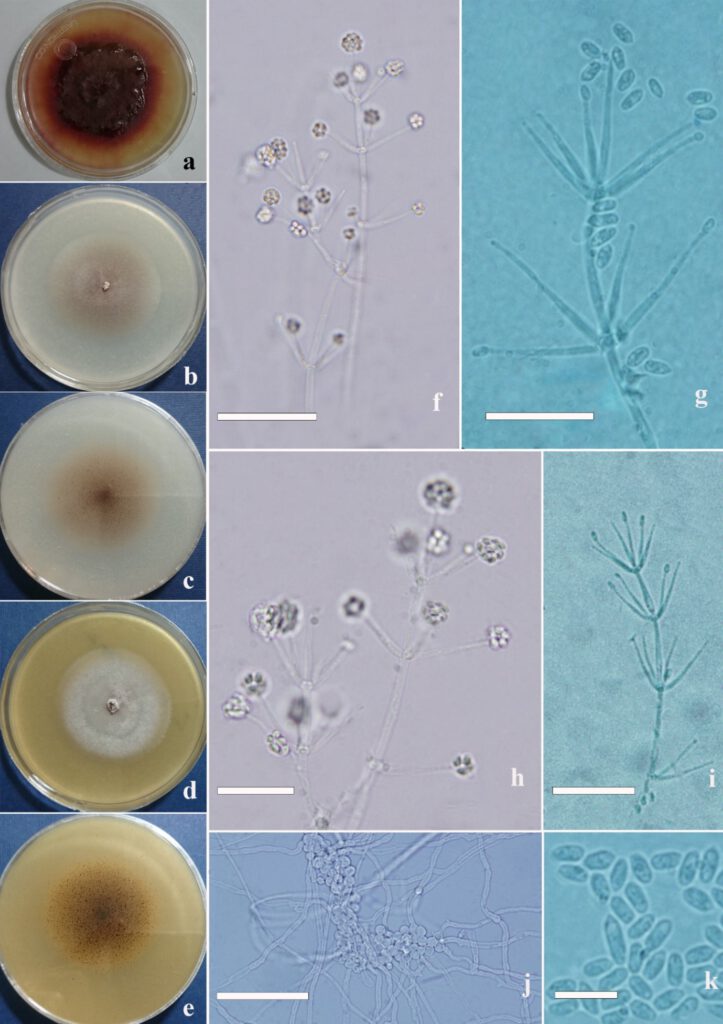Hypomyces iranica O. Karimi sp. nov., Figure 2
MycoBank number: MB; Index Fungorum number: IF; Facesoffungi number: FoF 12770;
Etymology: The name refers to the country, Iran, where the fungus was collected.
Holotype: FUM 1455
Saprobic on a submerged branch of Fagus sp. Asexual morph: Vegetative hyphae 1.0–2(−4) μm wide. Conidiophores arising from aerial hyphae, septate, branched, erect, up to over 320 μm tall, to 5 μm wide at the base, bearing 1–4 whorls of 1–6 phialides. Phialides 15–30 × 1–3 µm (x̄ = 21.17 × 2.82 μm, n = 70), subulate, hyaline, tapering toward the apex. Conidia 4–9 × 1–3 µm (x̄ = 4.9 × 2.03 μm, n = 120), forming globose heads, obovoid, rod-shaped to ellipsoidal, sharp-edged base, cyanophilic, aseptate, hyaline. Chlamydospores intercalary, single, chains or clusters, globose and hyaline 5.5–17 μm in diameter. Sexual morph: Undetermined.
Culture characters – Colonies on PDA, reached 35–40 mm in diameter in 10 days at 25 °C, cottony and floccose, initially white to grey and later on dark grey, producing pigments in the media. The media turned yellowish to dark orange after 2 weeks. Mycelium often superficial to immersed in media. On MEA, 25–30 mm in diameter in 10 days at 25 °C, slightly, cottony, white to grey, reverse yellowish to brown with black spots. On PCA, reaching 30–36 mm in diameter in 10 days at 25°C, superficial, white to grey, reverse pale brown. Crystals absent.
Materials examined – Iran, Mazandaran province, Sari. Sangdeh forest, Flord series, on dead branches of Fagus sp., 16 July 2017, O. Karimi (FUM 1455, holotype), ex-type (ABRIICC 10210).
Notes – Among the known Hypomyces species, H. iranica is morphologically similar to H. ellipsosporus Zare & W. Gams, H. subglobosus Zare & W. Gams, H. hubeiensis Z.Q. Zeng & W.Y. Zhuang, and H. tubariicola (W. Gams) Zare & W. Gams. Hypomyces ellipsosporus differs from our species in having mostly ellipsoidal, 5–7 × 3–4 μm conidia with apiculate base, cyanophilic, , rather shorter conidiophores producing whorls of up to 3–5 phialides and longer phialides (20–40 × 1.5–2.5 μm) (Zare & Gams 2016); H. subglobosus differs in having subglobose to short-cylindrical 4–5 × 3–3.5 μm conidia, slightly apiculate at the base, strongly cyanophilic, no chlamydospores (Zare & Gams 2016); H. hubeiensis differs by the smaller conidia (3–6 × 1–2.3 μm) and smaller phialides (8–20 × 2–3 μm) sizes, and no chlamydospores (Zeng & Zhuang 2019); H. tubariicola differs by having wider conidia (6–8.5 × 3.5–4.5 μm) with one or two guttules, and chlamydospores scarce in old cultures, single or short chains, globose, hyaline, 7.5–12 μm in diameter.

Fig. 2– Hypomyces iranica (ABRIICC 10210). a Colony on PDA. b, c Colony on PCA (above and below), d, e Colony on MEA (above and below). f-i Conidiophores and Phialides. J Chlamydospore. K Conidia. Scale bars: f = 200 μm, g = 50 μm, h = 200 μm, i =100 μm, j = 100 μm, k = 10 μm. (J, i and k stained with Lacto-phenol cotton blue).
